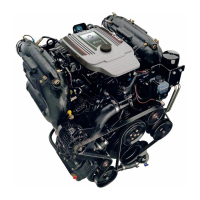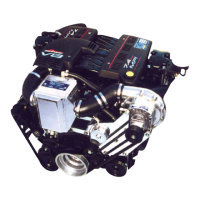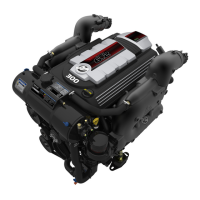MULTI-PORT FUEL INJECTION DESCRIPTIONS AND SYSTEM OPERATION SERVICE MANUAL NUMBER 23
Page 5B-4 90-861326--1 MARCH 1999
Electrostatic Discharge Damage
Electronic components used in control systems are often designed to carry very low voltage,
and are very susceptible to damage caused by electrostatic discharge. It is possible for less
than 100 volts of static electricity to cause damage to some electronic components. By com-
parison, it takes 4,000 volts for a person to even feel the effect of a static discharge.
There are several ways for a person to become statically charged. The most common
methods of charging are by friction and by induction. An example of charging by friction is
a person sliding across a seat, in which a charge of as much as 25,000 volts can build up.
Charging by induction occurs when a person with well-insulated shoes stands near a highly
charged object and momentarily touches ground. Charges of the same polarity are drained
off, leaving the person highly charged with the opposite polarity. Static charges of either type
can cause damage. Therefore, it is important to use care when handling and testing
electronic components.
Diagnostic Information
The diagnostic charts and functional checks in this manual are designed to locate a faulty
circuit or component through logic based on the process of elimination. The charts are
prepared with the requirement that the system functioned correctly at the time of
assembly and that there are no multiple failures.
Wiring Harness Service
Marine engine control circuits contain many special design features not found in standard
land vehicle wiring. Environmental protection is used extensively to protect electrical
contacts and proper splicing methods must be used when necessary.
The proper operation of low amperage input/output circuits depends upon good continuity
between circuit connectors. It is important before component replacement and/or during
normal troubleshooting procedures that a visual inspection of any questionable mating
connector is performed. Mating surfaces should be properly formed, clean and likely to
make proper contact. Some typical causes of connector problems are listed below.
1. Improperly formed contacts and/or connector housing.
2. Damaged contacts or housing due to improper engagement.
3. Corrosion, sealer or other contaminants on the contact mating surfaces.
4. Incomplete mating of the connector halves during initial assembly or during subsequent
troubleshooting procedures.
5. Tendency for connectors to come apart due to vibration and/or temperature cycling.
6. Terminals not fully seated in the connector body.
7. Inadequate terminal crimps to the wire.
Wire harnesses should be replaced with proper part number harnesses. When signal wires
are spliced into a harness, use the same gauge wire with high temperature insulation only.
With the low current and voltage levels found in the system, it is important that the best
possible bond be made at all wire splices by soldering the splices, as shown in the following
illustrations. Use care when probing a connector or replacing connector terminals. It is
possible to short between opposite terminals. If this happens, certain components can be
damaged. Always use jumper wires with the corresponding mating terminals between
connectors for circuit checking. NEVER probe through connector seals, wire insulation,
secondary ignition wires, boots, nipples or covers.
Microscopic damage or holes will result in eventual water intrusion, corrosion and/or compo-
nent or circuit failure.
Downloaded from https://needmanual.com/!
